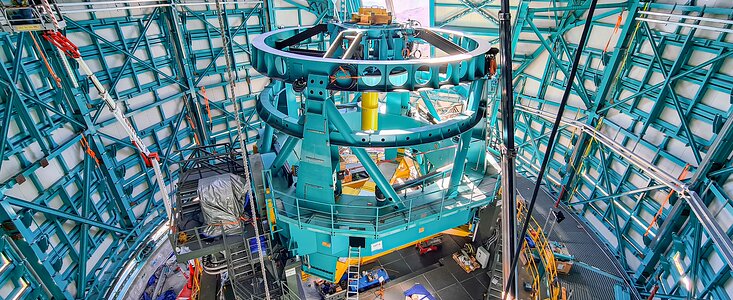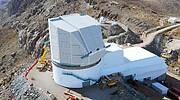The Rubin Observatory Telescope Mount Awakens
The Rubin Observatory telescope mount assembly moves for the first time
11 October 2021
In an exciting milestone at Cerro Pachón in Chile, Vera C. Rubin Observatory's telescope mount assembly was manually rotated in azimuth and elevation for the first time since testing at the Asturfeito factory in Spain. This test of the hydrostatic bearing system was successfully conducted in mid-September 2021.
The telescope mount left Spain and was shipped to Chile in August 2019. Once all the components of the mount had arrived on Cerro Pachón in Chile, the process of installing it in the summit facility began, but then had to be put on hold in March 2020 because of the COVID-19 pandemic. During the approximately 10 months that construction was either completely halted or confined to essential activities, the mount was stored safely inside the dome (which wasn’t complete yet) under a weatherproof tarp and inspected regularly by the small teams who were permitted to visit the summit. Completing the dome was a critical task that was given priority as soon as the Summit Dome team gained access to the summit; now the finished dome provides full protection for the telescope mount.
As construction activities started to ramp up again in late 2020, the Rubin summit teams focused on the deployment of the utility systems (including power, oil, and coolant) required for the telescope to operate. Once international contractors were able to enter Chile and work on the summit again, things started moving more quickly, and in September 2021 it was time to awaken the mount from its long sleep.
The hydrostatic bearing system for the mount is a complex combination of state-of-the-art industrial bearings and a high-pressure hydraulic oil film provided by the summit facility power plant. It allows the ~ 300-ton telescope structure to lift about 0.07 mm (70 microns, or about 3 thousandths of an inch — the approximate diameter of a human hair) above the pier track rail. The film of oil creates an almost zero-friction interface, which means that the enormous structure can be rotated in azimuth by just a few people using their hands.
During the tests, the telescope mount was also successfully rotated in elevation, from zenith to horizon. This rotation requires the accurate balance of the surrogate masses standing in for the future optical systems: the Primary/Tertiary Mirror (M1M3), the Secondary Mirror (M2) and the LSST Camera.
As a result of the manual tests, contracted personnel on the summit were able to confirm that the hydrostatic bearing pads were in good shape after the time in storage and that the hydrostatic bearing system is operating within specifications. From here, the Rubin summit teams will continue to work on installing the motors and completing the utility systems; these tasks will keep the teams busy through to the end of 2021. Another exciting milestone, the installation of the Commissioning Camera at the Top End of the telescope, is scheduled for early 2022.
More information
The National Science Foundation (NSF) and Department of Energy (DOE) will support Rubin Observatory in its operations phase to carry out the Legacy Survey of Space and Time. They will also provide support for scientific research with the data. During operations, NSF funding is managed by the Association of Universities for Research in Astronomy (AURA) under a cooperative agreement with NSF, and DOE funding is managed by SLAC under contract by DOE. Rubin Observatory is operated by NSF’s NOIRLab and SLAC.
NSF’s NOIRLab (National Optical-Infrared Astronomy Research Laboratory), the US center for ground-based optical-infrared astronomy, operates the international Gemini Observatory (a facility of NSF, NRC–Canada, ANID–Chile, MCTIC–Brazil, MINCyT–Argentina, and KASI–Republic of Korea), Kitt Peak National Observatory (KPNO), Cerro Tololo Inter-American Observatory (CTIO), the Community Science and Data Center (CSDC), and the Vera C. Rubin Observatory. It is managed by the Association of Universities for Research in Astronomy (AURA) under a cooperative agreement with NSF and is headquartered in Tucson, Arizona. The astronomical community is honored to have the opportunity to conduct astronomical research on Iolkam Du’ag (Kitt Peak) in Arizona, on Maunakea in Hawaiʻi, and on Cerro Tololo and Cerro Pachón in Chile. We recognize and acknowledge the very significant cultural role and reverence that these sites have to the Tohono O’odham Nation, to the Native Hawaiian community, and to the local communities in Chile, respectively.
Links
- Announcement on the Vera C. Rubin Observatory web site
- Photos of Vera C. Rubin Observatory
- Video of Vera C. Rubin Observatory
Contacts
Amanda Kocz
Press and Internal Communications Officer
NSF NOIRLab
Cell: +1 520 318 8591
Email: amanda.kocz@noirlab.edu



